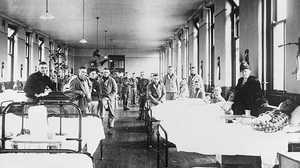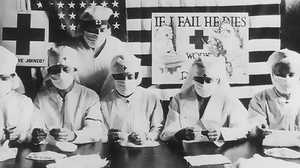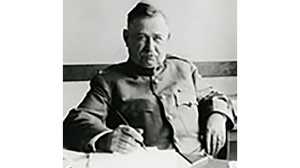Biography: Rupert Blue
In 1918, the nation’s top medical specialists had not yet reached a consensus on exactly what influenza was. Before trying to define the disease for an alarmed citizenry, public health officials debated amongst themselves. A large part of the burden of informing and protecting the public fell to 50-year-old Rupert Blue, Surgeon General of the United States Public Health Service. Blue was in sole command of 180 health officers and 44 quarantine stations throughout the country. Blue’s 1918 advisory to the nation regarding how to recognize influenza stated:
“In most cases a person taken sick with influenza feels sick rather suddenly. He feels weak, has pains in the eyes, ears, head or back, abdomen, etc., and may be sore all over. Many patients feel dizzy… Ordinarily the fever lasts from three to four days and the patient recovers. But while the proportion of deaths is usually low, in some places the outbreak is severe and deaths are numerous…”

In the early autumn days of the outbreak, Blue was particularly concerned that military bases be prepared for an onslaught of illness. He issued urgent bulletins to camps on the dangers of making incorrect diagnoses:
“It is important that influenza be kept out of the camps as far as practicable. To this end it must be recognized as a disease which is distinct and separate from the so-called 'cold, bronchitis, laryngitis, coryza, or rhinitis and fever type,’ which are continually with us and from time to time become prevalent.”
By the time Blue delivered these guidelines, however, influenza had already established a foothold in military camps from Massachusetts to Louisiana and was starting to make its presence felt as far west as Camp Kearny in California.
Blue’s other concern was shoring up the nation’s ranks of medical professionals — depleted by World War I — to care for influenza victims. Using the influence of his office and relying on contacts he had made throughout his career, Blue summoned scores of doctors out of retirement, including those debilitated by old age, disfigurement, and in some cases, near-blindness. Somehow Rupert Blue was able to enlist 250 additional doctors to aid the Public Health Service. He also tried to impress upon civic leaders the severity of the influenza, and went on record as being in favor of closing “all gathering places if the community is threatened with the epidemic. This,” Blue contended, “will do much toward checking the spread of the disease.”
When claims of vaccines and folk cures tempted citizens to let their guard down, Blue warned:
“The Health Service urges the public to remember that there is as yet no specific cure for influenza and that many of the alleged cures and remedies now being recommended by neighbors, nostrum vendors and others do more harm than good.”
In the epidemic’s aftermath, Rupert Blue was among those calling for a more organized national approach to public health and proposed a “centralized national department of health with powers far greater than the U.S.P.H.S. had ever had before…”







